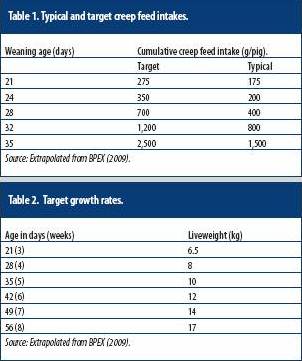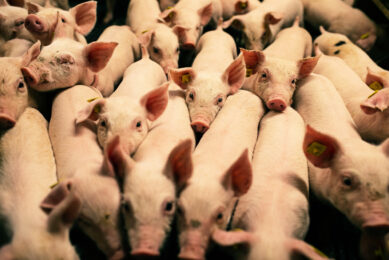What the textbooks don’t tell you about…Creep feeding (1)

If you look up the indexes of those pig textbooks published over the past 15 years, you will find that the authors are in favour of the practice and are helpful in describing how to creep feed effectively.
By John Gadd
All the more surprising therefore to find mixed opinions among pig farmers as to their value, seemingly based on their own experiences of trying to feed solid food to sucklers. This is particularly evident at some pig discussion groups and specialised training courses where I have sat at the back as an observer and listened to the opinions.
I find the same difference of opinion when remarking about creep feeding on several of the farms I visit. Those ‘against’ telling me: “We never found it worthwhile”, or: “Too much trouble for the effort involved”, or: “The feeds are too expensive!”.
On the other hand the comments for those ‘for’ vary from: “I suppose it does some good” to: “Wouldn’t dream of not creep feeding.”
When opinions differ at the discussion group meetings on baby pig management, up pop the feed company sales reps saying to the doubters: “Well, you aren’t feeding the right creep feeds – try ours!” This may or may not be true. Let me explain.
Things have changed
Things have changed in two ways. Firstly, creep feeds have changed out of all recognition over the past ten years. They are now very gut-friendly. The piglet’s digestive tract is extremely sensitive at the critical transition from sow’s milk to solid food. Give it half a chance and the tract becomes dysfunctional and the piglet gets loose – or worse. Put simply and rather unscientifically, the problem is that the dam’s milk is almost completely digestible, while solid food is not.
The revolution in creep feed design has been to exclude nutritious (but gut damaging) and price-affordable raw materials; heat treat and thus modify others; include only those which are easily digestible at and around weaning time, and go on to include others which do a specific job. One such major step forward is egg protein powder from hens which have been specially immunised to those pathogens which can proliferate when weaning occurs and the piglet has to eat solid food. The piglet then absorbs these protective antigens.
Expensive, but worthwhile?
Definitely! All these nutritional advances have markedly increased the price per bag of these superfeed creeps, causing the concern over price. But rest assured – I have done the sums elsewhere and find that the benefit of a good post-weaning getaway to growth comes not so much at the end of the nursery stage, which the
textbooks mention, but at slaughter weight.
While the price of these new superfeed creeps can be double what was quoted in the past, the payback from saved food and overheads at shipping can well be twice and even three times that initial outlay, as the baby pigs eat so little in comparison to what they consume in the mid- and later growing stages. Ergo – you can afford to pay about three times more compared to the price of a normal creep feed of a few years ago before break-even is reached. The cost of the newer creep feeds are nowhere near that.
Later weaning/bigger litters
The second change affecting creep feeding is that more breeders are weaning at 28 days so as to improve the post-weaning getaway. Modern genetics promise two more weaners/litter than 10-15 years ago. This puts a huge additional strain on the modern sow and creep feeding this mob of little monsters helps defend her against too much condition loss, mostly maternal protein, and subsequent rebreeding damage. These days creep feeding is not ‘advisable’ as some textbooks still say, but essential.
But it’s not all down to diet design
The rep could well be right when he suggests: “You aren’t feeding the right creep feed.” Several producers counter this by saying: “But I have been using your gold-plated stuff and it hasn’t made a detectable difference!” I’ve been on farms where this has happened and have looked for the reason(s). There are four main ones – three which the textbooks mention and one they don’t – or gloss over. In my experience, the fourth one is fundamental in getting pigs to eat the amounts of creep feed in Table 1 and thus have a chance of reaching the superlative post-weaning growth rates in Table 2. These targets depend on the right creep feeds fed in the right way. This I will deal with in the next issue.











